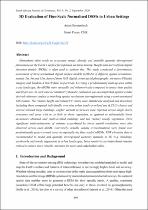JavaScript is disabled for your browser. Some features of this site may not work without it.
- ResearchSpace
- →
- Research Publications/Outputs
- →
- Journal Articles
- →
- View Item
| dc.contributor.author |
Breytenbach, Andre

|
|
| dc.date.accessioned | 2021-02-26T12:53:44Z | |
| dc.date.available | 2021-02-26T12:53:44Z | |
| dc.date.issued | 2020-09 | |
| dc.identifier.citation | Breytenbach, A. 2020. 3D evaluation of fine-scale normalised DSMs in urban settings. <i>South African Journal of Geomatics, 9(2).</i> http://hdl.handle.net/10204/11808 | en_ZA |
| dc.identifier.issn | 2225-8531 | |
| dc.identifier.uri | http://hdl.handle.net/10204/11808 | |
| dc.description.abstract | Humankind often needs to accurately model, identify and spatially quantify aboveground phenomena on the Earth’s surface for informed decision-making. Height data derived from digital elevation models (DEMs) is often used to achieve this. This study conducted a deterministic assessment of three normalised digital surface models (nDSMs) of different spatial resolutions, namely 2m, 4m and 12m, derived from VHR digital stereo aerial photography, tri-stereo Pléiades imagery and Tandem-X InSAR data, respectively. Covering a predominantly built-up area within a city landscape, the nDSMs were vertically and volumetrically compared to assess their quality and fit-for-use. In each case a consistent systematic evaluation was accomplished against a lidar derived reference surface at matching spatial resolutions (co-registered) using a semi-automated GIS routine. The relative height and volumetric errors were statistically analysed and described, including those computed individually over nine urban land cover/land use (LCLU) classes and several selected large buildings. Higher vertical accuracies were reported across single storey structures and areas with no to little or short vegetation, as apposed to substantially lower accuracies obtained over multi-levelled buildings and tall (dense) woody vegetation. Here significant underestimations of volumes exacerbated by lower spatial resolutions were also observed across each nDSM. Conversely, notable volume overestimations were found over predominantly grass-covered areas in especially the finer-scaled nDSMs. VHR elevation data is recommended to model and quantify aboveground elements spatially in 3D (e.g. buildings, earthworks and woody vegetation) in urban landscapes, but a sensitivity test beforehand remains critical to ensure more reliable outcomes for users and stakeholders alike. | en_US |
| dc.format | Fulltext | en_US |
| dc.language.iso | en | en_US |
| dc.relation.uri | https://www.sajg.org.za/index.php/sajg/article/view/854 | en_US |
| dc.relation.uri | DOI: http://dx.doi.org/10.4314/sajg.v9i2.26 | en_US |
| dc.source | South African Journal of Geomatics, 9(2) | en_US |
| dc.subject | Urban settings | en_US |
| dc.subject | Normalised Digital Surface Models | en_US |
| dc.subject | URD CityPlan | en_US |
| dc.title | 3D evaluation of fine-scale normalised DSMs in urban settings | en_US |
| dc.type | Article | en_US |
| dc.description.pages | 18 | en_US |
| dc.description.note | Open access article published in South African Journal of Geomatics, Vol. 9. No. 2, September 2020 | en_US |
| dc.description.cluster | Smart Places | en_US |
| dc.description.impactarea | Urban and Regional Dynamics | en_US |
| dc.identifier.apacitation | Breytenbach, A. (2020). 3D evaluation of fine-scale normalised DSMs in urban settings. <i>South African Journal of Geomatics, 9(2)</i>, http://hdl.handle.net/10204/11808 | en_ZA |
| dc.identifier.chicagocitation | Breytenbach, Andre "3D evaluation of fine-scale normalised DSMs in urban settings." <i>South African Journal of Geomatics, 9(2)</i> (2020) http://hdl.handle.net/10204/11808 | en_ZA |
| dc.identifier.vancouvercitation | Breytenbach A. 3D evaluation of fine-scale normalised DSMs in urban settings. South African Journal of Geomatics, 9(2). 2020; http://hdl.handle.net/10204/11808. | en_ZA |
| dc.identifier.ris | TY - Article AU - Breytenbach, Andre AB - Humankind often needs to accurately model, identify and spatially quantify aboveground phenomena on the Earth’s surface for informed decision-making. Height data derived from digital elevation models (DEMs) is often used to achieve this. This study conducted a deterministic assessment of three normalised digital surface models (nDSMs) of different spatial resolutions, namely 2m, 4m and 12m, derived from VHR digital stereo aerial photography, tri-stereo Pléiades imagery and Tandem-X InSAR data, respectively. Covering a predominantly built-up area within a city landscape, the nDSMs were vertically and volumetrically compared to assess their quality and fit-for-use. In each case a consistent systematic evaluation was accomplished against a lidar derived reference surface at matching spatial resolutions (co-registered) using a semi-automated GIS routine. The relative height and volumetric errors were statistically analysed and described, including those computed individually over nine urban land cover/land use (LCLU) classes and several selected large buildings. Higher vertical accuracies were reported across single storey structures and areas with no to little or short vegetation, as apposed to substantially lower accuracies obtained over multi-levelled buildings and tall (dense) woody vegetation. Here significant underestimations of volumes exacerbated by lower spatial resolutions were also observed across each nDSM. Conversely, notable volume overestimations were found over predominantly grass-covered areas in especially the finer-scaled nDSMs. VHR elevation data is recommended to model and quantify aboveground elements spatially in 3D (e.g. buildings, earthworks and woody vegetation) in urban landscapes, but a sensitivity test beforehand remains critical to ensure more reliable outcomes for users and stakeholders alike. DA - 2020-09 DB - ResearchSpace DP - CSIR J1 - South African Journal of Geomatics, 9(2) KW - Urban settings KW - Normalised Digital Surface Models KW - URD CityPlan LK - https://researchspace.csir.co.za PY - 2020 SM - 2225-8531 T1 - 3D evaluation of fine-scale normalised DSMs in urban settings TI - 3D evaluation of fine-scale normalised DSMs in urban settings UR - http://hdl.handle.net/10204/11808 ER - | en_ZA |
| dc.identifier.worklist | 24248 | en_US |






